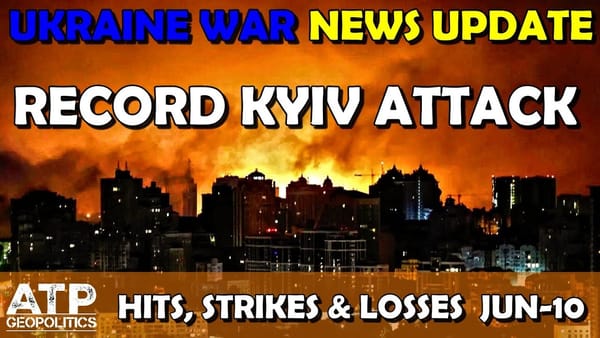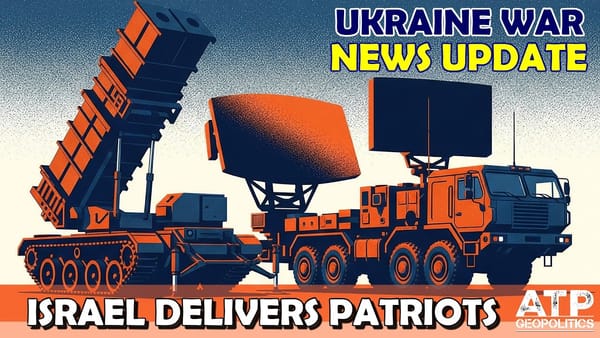Ukraine War Update NEWS: Military Aid News - Johnson Bills Analysis: Bad News
Table of Contents 📖
"What I presented to the conference tonight is is our play call on this. What we'll do is bring to the House floor independent measures. We won't be voting on the Senate supplemental in its current form, but we will vote on each of these measures separately in four different pieces."
Hello Team
🎦 00:00-00:26⏩
Jonathan welcomes viewers to a slightly later than usual Ukraine War News Update, attributing the delay to feeling a bit unwell. He acknowledges that the video is packed with information, mainly due to recent announcements by US House Speaker, Mike Johnson.
Return to top⤴️
EU Aid for Ukraine
🎦 00:26-01:31⏩
- The European Commission approves a four-year, €50 billion ($53 billion) reform and investment plan for Ukraine.
- The Netherlands allocates $4.7 billion in support of Ukraine until 2026, as part of the previously agreed €50 billion EU support package.
Drone Coalition Updates
🎦 01:31-03:36⏩
- The Netherlands, Denmark, and Germany are collaborating to supply Ukraine with RQ-35 Hydron drones worth €200 million as part of the Capability Coalition.
- Germany will also provide an additional 211 Vector drones (€38 million).
- Jonathan praises the Netherlands for their support, noting the significance of this drone coalition.
- Canada announces the transfer of 450 multi-purpose Skyranger drones to Ukraine, beginning in the summer.
- Lithuania pledges €3 million towards the production of FPV drones for Ukraine.
Ukrainian Arms Procurement
🎦 03:36-06:09⏩
- Ukraine has allocated €6 billion from its 2024 defence budget for arms procurement, primarily from domestic manufacturers.
- Strategic Industries Minister, Oleksandr Komyshyn, states that Ukrainian production capacity is three times greater than this allocated amount.
- Jonathan questions the low allocation in light of Ukraine's production capabilities.
- Ukraine plans to increase the range of its Neptune anti-ship missiles to 1,100km, extending their reach to 59 of Russia's 99 airbases, as well as increasing production tenfold.
- Jonathan expresses doubt over the efficacy of using a unitary warhead like the Neptune to target airfields, suggesting that a large number of drones or cluster munitions would be more effective.
- He speculates that Western nations may be sharing technology with Ukraine, enabling them to produce advanced weaponry domestically.
New Ukrainian Submarine Vessel
🎦 07:20-08:02⏩
- A Ukrainian-designed submarine vessel, capable of firing torpedoes and rockets, has undergone warfare testing.
- The vessel can accommodate 10 passengers and carry a payload of explosives.
- Jonathan expresses astonishment at the vessel's size and speculates about potential collaboration with the UAE on the project.
David Cameron on Air Defence for Ukraine
🎦 08:02-15:37⏩
- Jonathan analyses a recent interview with former UK Prime Minister, David Cameron, on LBC, where he discusses the provision of air defence systems to Ukraine.
- Cameron argues that directly engaging Russian troops with NATO forces would be escalatory and therefore providing weapons and training is a more sensible approach.
- Jonathan challenges Cameron's assertion that the UK has contributed more than any other country individually, highlighting the lack of quantifiable evidence for this claim.
- He criticises Cameron for evading the question of why the West provides air defence support for Israel but not Ukraine, suggesting that the underlying reason is fear of nuclear escalation with Russia.
- Jonathan points out that while Cameron is right to advocate for more Patriot missile systems for Ukraine, the UK doesn’t possess any and relies on ship-based air defence due to its island geography.
- He expresses a preference for ship-based systems as they provide better coverage for the UK.
NASAMS and Patriot for Ukraine
🎦 15:37-16:05⏩
- The Ukrainian and Norwegian Foreign Ministers confirm ongoing talks to strengthen Ukraine's NASAMS air defence capabilities.
- Both countries are also exploring the provision of Patriot systems to Ukraine.
- Jonathan mentions a rumour about Norway's potential interest in acquiring Patriot systems, possibly for licensed production, which could boost global supply.
F-16 Fighter Jet Updates
🎦 16:09-18:20⏩
- Norway will supply Ukraine with a "significant number" of F-16 fighter jets, equipped with the latest weaponry, to bolster their strike capabilities.
- However, the Greek Prime Minister, Kyriakos Mitsotakis, has ruled out sending F-16s to Ukraine, citing national security concerns due to Greece’s location.
- Jonathan questions whether this refers to additional F-16s as Greece has been looking to divest some of its soon-to-be obsolete airframes, some of which were rumoured to be earmarked for Ukraine.
The Economic Impact of Defence Projects - The Eurofighter Typhoon Example
🎦 18:20-20:30⏩
- Jonathan discusses the economic benefits of domestic arms manufacturing, citing a report highlighting the Eurofighter Typhoon project’s contribution of €90 billion to European GDP and supporting 98,000 jobs across the continent.
- He emphasises the significance of the recently announced European military strategy to source 60% of equipment domestically, keeping investment and tax revenues within local economies.
- He questions how the UK, post-Brexit, can position itself to benefit from EU military spending and procurement programmes.
Fire at US Artillery Shell Production Facility
🎦 20:30-21:40⏩
- A fire has broken out at the Scranton Army Ammunition Plant in Pennsylvania, a key US production facility for 155mm artillery shells.
- Jonathan expresses concern over the potential impact on US artillery shell production, noting that the cause of the fire remains unknown.
- Frontline Ukrainian units are experiencing a critical shortage of armoured personnel carriers, including US-made M113s and Soviet-era BMP vehicles, impacting their ability to evacuate casualties.
- Jonathan encourages viewers to donate to his ongoing fundraising campaign with Greg, Terry, Professor Girdys, and Rick (from Ukraine) to provide Ukraine with four Land Rover Snatchers modified as armoured medical evacuation vehicles, equipped with drone protection.
US Aid Package and Mike Johnson’s Statements
🎦 21:40-31:06⏩
- Jonathan analyses recent comments by US House Speaker, Mike Johnson, concerning the proposed aid package for Ukraine.
- Congressman Joe Courtney urges the House to pass the supplemental funding bill, already approved by the Senate (70-28 vote), to provide aid to Ukraine, Israel, and Taiwan, reminding the House of its historical role as the "arsenal of democracy."
- Johnson proposes dividing the Senate's supplemental funding bill into four separate bills: Israel aid, Ukraine aid, Indo-Pacific aid, and a national security bill incorporating loan lease options, sanctions on Iran, and other measures.
- Jonathan is critical of Johnson's approach, arguing that it is a tactic to delay and potentially derail aid to Ukraine, particularly as the Senate bill, if put to a vote in the House, would likely pass.
- He argues that the separate bills create more opportunities for opposition and amendments, slowing down the process, and highlights the higher likelihood of the Ukraine aid bill facing resistance from Republicans compared to the Israel aid bill from Democrats.
- He expresses concern that Johnson's proposal prioritises appeasing those within his party who are against supporting Ukraine over the urgent needs of the Ukrainian people.
- While acknowledging that Johnson's plan, if successful, is better than no aid, Jonathan questions Johnson’s motives, believing it reflects a desire to appease former President Trump and certain Republican factions who oppose aiding Ukraine.
Analysis of Johnson's Proposed Bills
🎦 31:06-41:49⏩
- Jonathan cites analysis by Jake Broe, who argues that Johnson’s plan is a political trap designed to ensure aid reaches Israel while hindering aid to Ukraine.
- Broe suggests that by dividing the bill, Senate Republicans are likely to approve Israel aid but then filibuster the standalone Ukraine aid bill, effectively killing it.
- Jonathan agrees with this assessment, pointing out that previous votes on Ukraine aid, even when linked to Israel aid, faced opposition from 30 senators, with the potential for more if influenced by Trump.
- He highlights the possibility of Senate Republicans amending the standalone Ukraine aid bill, forcing it back to the House, where Johnson could then refuse to allow a vote, further delaying assistance.
- A leaked version of the proposed bills reveals $48.43 billion allocated for Ukraine but potentially less than the supplemental aid package after accounting for humanitarian aid.
- Jonathan analyses a comparison chart by Colby Badwar, showing that while Johnson’s proposal might appear to offer more than the Biden administration’s request and the Senate bill, it falls short of what Ukraine actually needs to achieve victory.
- He breaks down the proposed Ukraine aid bill: $13.8 billion for USAI (orders for military equipment), $7.85 billion in economic aid, and $19.85 billion for replenishing US military stocks, noting that this replenishment money can’t be directly sent to Ukraine.
- He contrasts this with the Senate bill, which included $8 billion in presidential drawdown authority, enabling the immediate transfer of equipment from US stockpiles to Ukraine.
- Jonathan believes that the lack of drawdown authority in Johnson's proposal is a major issue as it would significantly delay Ukraine receiving crucial equipment.
- He is also critical of the loan aspect for the USAI funding, arguing that it burdens Ukraine with further debt. He believes the loans are included solely to appease Trump and calls for the use of seized Russian assets to repay them.
- He concludes by emphasising that both the House and Senate packages fall short of providing the $60 billion Ukraine needs, with the Senate potentially offering $30-34 billion (excluding Foreign Military Financing) and the House package only $21.65 billion if presidential drawdown authority is not included.
Russia's Recruitment Efforts
🎦 42:34-46:51⏩
- Russia is intensifying its recruitment efforts to bolster its forces in Ukraine, targeting foreign nationals with offers of high salaries, signing bonuses, Russian passports, and other benefits.
- Online advertisements specifically target citizens of neighbouring countries, such as Armenia and Kazakhstan, as well as migrant workers from Central Asia, India, and Nepal.
- The UK Defence Intelligence update notes that many recruits are not professional soldiers and are likely coerced or misled into service due to financial incentives.
- Jonathan highlights the desperation in Russia’s recruitment drive, reflecting heavy casualties (estimated at 913 per day) and an aversion to further unpopular domestic mobilisation.
- He cites reports suggesting Russia is mobilising approximately 1,000 troops daily, combining foreign recruitment with coercion within occupied Ukrainian territories, forcing Ukrainians to fight against their own.
Redeployment of Russian Forces from Africa
🎦 46:51-47:51⏩
- Chris O’Wickey reports that Russia is withdrawing units from its Afrika Korps and redeploying them to the Belgorod region, bordering Ukraine, which has seen recent incursions by the pro-Ukrainian Russian Volunteer Corps (Free Legion).
- Jonathan infers that this redeployment might be a response to the Free Legion attacks.
Wrap up
🎦 47:51-46:54⏩
Jonathan concludes the video, expressing the need for a soothing cup of tea after presenting a dense amount of information.
Return to top⤴️



